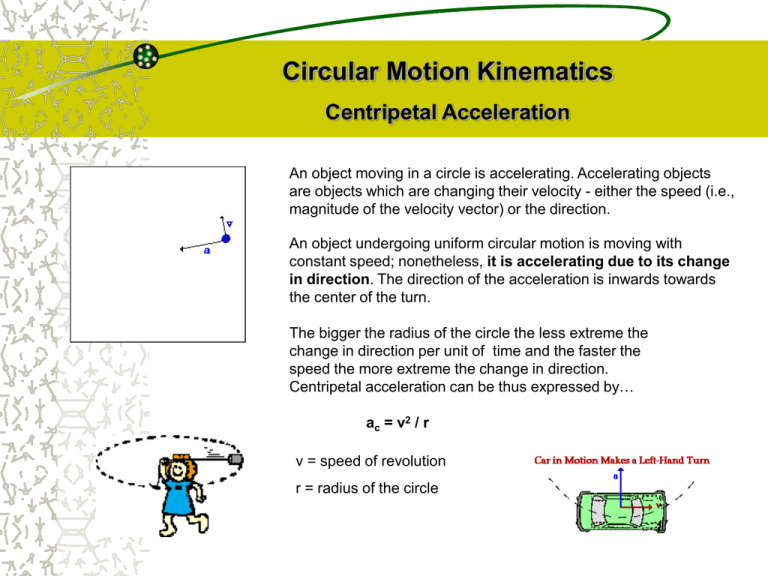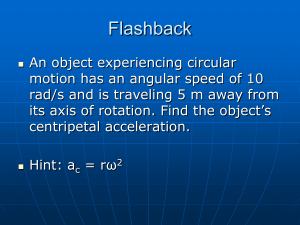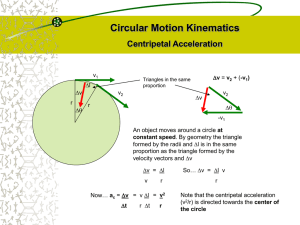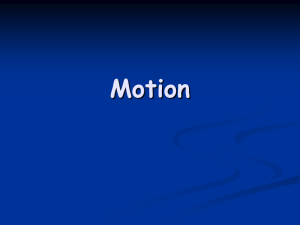Circular Motion (PowerPoint)
advertisement

Circular Motion Kinematics Centripetal Acceleration An object moving in a circle is accelerating. Accelerating objects are objects which are changing their velocity - either the speed (i.e., magnitude of the velocity vector) or the direction. An object undergoing uniform circular motion is moving with constant speed; nonetheless, it is accelerating due to its change in direction. The direction of the acceleration is inwards towards the center of the turn. The bigger the radius of the circle the less extreme the change in direction per unit of time and the faster the speed the more extreme the change in direction. Centripetal acceleration can be thus expressed by… ac = v2 / r v = speed of revolution r = radius of the circle Circular Motion Dynamics Centripetal Force According to Newton’s second law (Fnet = ma) an object moving in a circle at constant speed must have a net force in the same direction as the acceleration…. This must be towards the center of the circle Fc = m v2 r The force that keeps a car moving around a bend in the road at constant speed is friction directed towards the center of the turn The force that keeps the moon moving around the earth at a constant rate is the force of gravity directed towards the center of the Earth. Circular Motion Dynamics Centripetal Force A 1000 kg car rounds a curve on a flat road of radius 50m at a speed of 14m/s. Will the car make the turn of will it skid if a) the pavement is dry (Ffr = 5880 N) and b) the pavement is icy (Ffr = 2450 N )? c) Does the ability of the car to make the turn depend on the mass of the car? m = 1000 kg r = 50m v = 14 m/s a) FFr = 5880 N Force needed is… FC = m v 2 r = (1000kg)(14m/s) 2 = 3920 N (50m) The maximum friction force that can be provided by the car’s tires is bigger than the force needed to keep the car turning so it will be able to make the turn b) FFr = 2450 N The maximum friction force that can be provided by the car’s tires is now smaller than the force needed to keep the car turning so it won’t be able to make the turn c) The more mass the car has, the more friction between the tires and the road but the car has proportionally more resistance to a change in motion. This will offset the increased friction, so bigger cars can’t turn quicker. (plus the higher center of gravity makes them more likely to role!) Circular Motion Dynamics Centripetal Force The Moon (m= 7.35 x 1022 kg) orbits the Earth at a distance of 384 x 106 m. a) What is the moon’s acceleration towards the Earth? b) How much does the Earth pull on the moon? c) Does the moon pull on the Earth more or less or the same as the Earth pulls on it? (The moon moves around the Earth one orbit every 27.4 days) mm = 7.35 x 1022 kg r = 384 x 106 m T = 27.4 days v = ? Fg = ? v = d / t = 2r / T Fc v v = 2 (384 x 106m) / (27.4D x 24 H/D x 3600 s/H) = 1019 m/s ag = v 2 = (1019 m/s)2 = 0.0027 m/s2 (384 x 106 m) r Fg = mm v 2 r = (7.35 x 1022kg) (1019 m/s)2 = 1.99 x 1020 N (384 x 106 m) The moon pulls equally back on the Earth according to Newton’s third law of motion. The moon moves around the Earth because of its much smaller mass (inertia). Circular Motion Dynamics Universal Gravitation We can define a field as an area of force that surrounds an object. Gravitational fields exist around all masses. The amount of gravitational force between two objects is due to the amount of mass each object has. It decreases in strength with distance in proportion to the inverse of the distance squared. M1 Fg Fg r M2 Fg = G M1 M2 r122 G = Universal Gravitational Constant = 6.67 x 10-11 Nm2/kg2 M = Mass of objects (kg) r = distance separating centers of masses (m) Circular Motion Dynamics Universal Gravitation What is the force of gravity acting on a 65kg man standing on the surface of planet Earth? (rearth = 6.38 x 106 m, MEarth = 5.97 x 1024 kg) Fg = G ME MM MM rE2 Fg rE Fg = 6.67 x 10-11Nm2/kg2 (5.97 x 1024kg)(65kg) (6.38 x 106m)2 ME Fg = 635.9 N = 636 N Check: Fg = mM g = (65kg) (9.81N/kg) = 637.6 N = 638 N Circular Motion Dynamics Gravitational Field Strength Field strength is defined as the amount of force per quantity. For a gravitational field around an object it is the number of Newton’s of force acting on every kg of a second object placed in this field. g = Fg g r122 M2 r12 M1 = G M1 What is the gravitational field strength on the surface of the moon? (Mm = 7.35 x 1022 kg, rm = 1.74 x 106 m) gM = G MM r M2 gM = 6.67 x 10-11Nm2/kg2 7.35 x 1022 kg (1.74 x 106m)2 (about 1/6 that on the surface of Earth) = 1.62 N/kg Circular Motion Dynamics Gravitational Field Strength A typical white dwarf star, which once was an average star like our sun but is now in the last stages of its evolution, is the size of our moon but has the mass of our sun. What is the surface gravity (g) of this star? (Ms = 1.99 x 1030 kg) g gWD = G MS r M2 rM MS gWD = 6.67 x 10-11Nm2/kg2 1.99 x 1030 kg = 4.38 x 107 N/kg (1.74 x 106m)2 (This is about 4.5 million times our surface gravity on Earth) Circular Motion Dynamics Gravitational Potential Gravitational Potential Energy is the energy an object has due to its position in a gravitational field. The change in GPE (GPE) between two points at different distances from an object we have already expressed as - M2gdv according to the work-energy theorem now….g = G M1 GP r122 The gravitational potential energy of mass M2 at distance r12 can be defined as…. GPE = - G M1 M2 r12 M1 r12 Like field strength, the amount of potential energy per kg of a second object placed at this position in the gravitational field is called gravitational potential GP = - G M1 r12 The GPE and GP get smaller the further you go from the mass M1. They both are reduced to zero at infinity. It should also be noted that the work done to move a mass between two points in a gravitational field is independent of the path taken. (proved by calculus) Circular Motion Dynamics Escape Speed How much speed is needed to send a rocket (M2) soaring into space so that it escapes the pull of a planet (M1)? ve If the rocket just makes it to infinity and slows down all the way its final velocity (vf) will be zero and its final GPE will be zero so the total energy will be zero KEi + PEi = KEf + PEf = 0 1/2 M2 ve2 - G M1 M2 = 0 rp r M1 ve = 2G M1 rp Determine the escape speed from the surface of earth rearth = 6.38 x 106 m MEarth = 5.97 x 1024 kg G = 6.67 x 10-11 Nm2/kg2 ve = 2G ME = (2(6.67 x 10-11 Nm2/kg2) (5.97 x 1024 kg )) rearth 6.38 x 106 m = 11.2 x 103 m/s (25000 mi/h) Circular Motion Dynamics Escape Speed - Black Hole When a huge star many times our own sun’s mass runs out of nuclear fuel gravity causes it to collapse in on itself eventually resulting in an incredibly dense piece of matter. Light has a speed (c) of 3 x 108 m/s. If the escape speed is greater than this not even light will escape. Karl Schwarzchild calculated the radius around a black hole at which light wouldn’t be able to escape. This boundary is called the event horizon (R) c = 2G MBH R R MBH So ….R = 2G MBH c2 If a black hole has a mass of 3 times our own sun’s mass and a radius of 2km determine its event horizon (Ms = 1.99 x 1030 kg) c = 3 x 108 m/s R = MBH = 5.97 x 1030 kg G = 6.67 x 10-11 Nm2/kg2 2G MBH = 2(6.67 x 10-11 Nm2/kg2) (5.97 x 1030 kg ) c2 (3 x 108)2 m = 8850m (8.9 km) Circular Motion Dynamics Satellites and Weightlessness Satellites are freefalling towards the earth just as a dropped ball falls towards earth but they have such high tangential velocities that as they fall they follow the curvature of the planet. The earth’s surface drops about 5m for every 8km horizontally. How fast should a projectile be fired to go into a low orbit around the earth? A projectile falls about 5m in 1s so it should be fired at 8km/s (18000 mi/h) Motion of projectile without gravity If the tangential speed is high enough the projectile will fall “around the earth” Circular Motion Dynamics Satellites and Weightlessness How can someone in the space shuttle be experiencing weightlessness when the spacecraft is experiencing nearly as much gravitational acceleration (g) as someone on the surface? An airborne athlete and an astronaut both experience weightlessness Circular Motion Dynamics Satellites and Weightlessness Our experience of weight is really the normal force of the surface we are in contact with pushing back on our body You are made aware of this idea when traveling on a high speed elevator or riding on an amusement park ride. The normal force has a small magnitude at the top of the loop (where the rider often feels weightless) and a large magnitude at the bottom of the loop (where the rider often feels heavy). Circular Motion Dynamics Apparent Weightlessness Consider a roller coaster track that has a series of hills and dips as shown below. The black arrows show that the centripetal acceleration is directed towards the center of the circular shaped arcs as the car moves along the track. The forces acting on the car at positions A, B and D are shown below Circular Motion Dynamics Apparent Weightlessness Consider a roller coaster moving over a series of hills as shown on the previous slide. At the bottom of a hill the track has do do two things: i) It has to support the car’s weight which means that it has to provide a normal force (FN) upwards ii) It also has to change the motion of the car because the path that the car follows is curved (not straight!). Because the direction of motion changes constantly the track has tp provide a centripetal force towards the center of the turn. Therefore…… FN = Fg + FC = mg + mv2 / r = m (g + v2 / r ) Circular Motion Dynamics Apparent Weightlessness FN At the top of the hill the track can push upwards or pull downwards depending on the car’s speed. i) If the car travels slowly over the top FN is directed upwards but is a little bit smaller than Fg (down) because the car starts to lift just a little bit off the track because it wants to continue in a straight line path as it goes over the top ii) If the car travels fast over the top FN is directed downwards because the car actually lifts a lot off the track but a second set of wheels below the track stop the car from moving upwards so the track applies a force back down (3rd Law) on the car (Fapp) Notice that both the top and bottom of the hill there is an unbalanced force (FNET) towards the center of the turn. This is the centripetal force (FC) that allows the car to follow the curved track Also note that at some speed between fast and slow the passengers in the car (and the car itself) will not receive a normal force and so will feel weightless.








